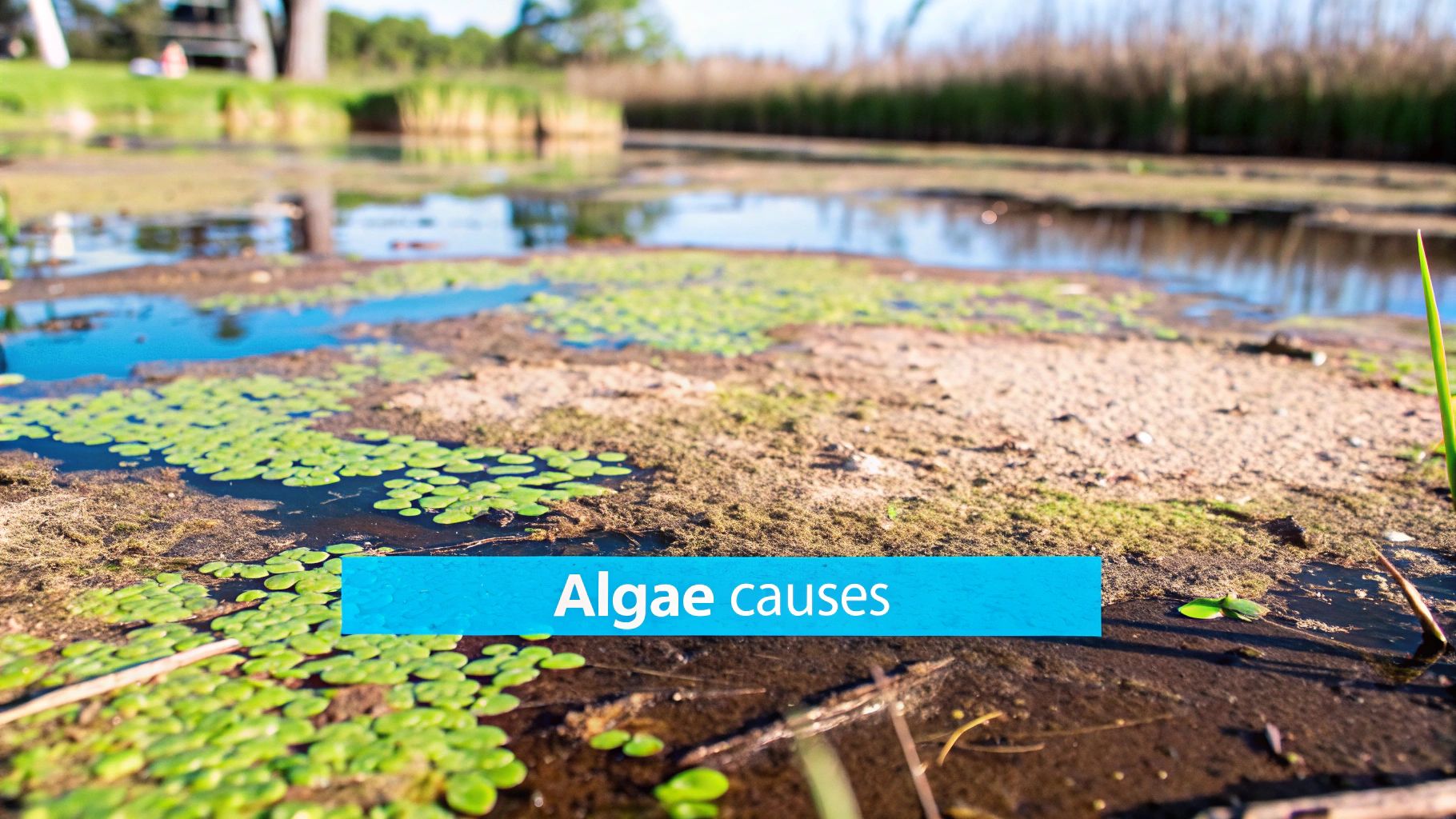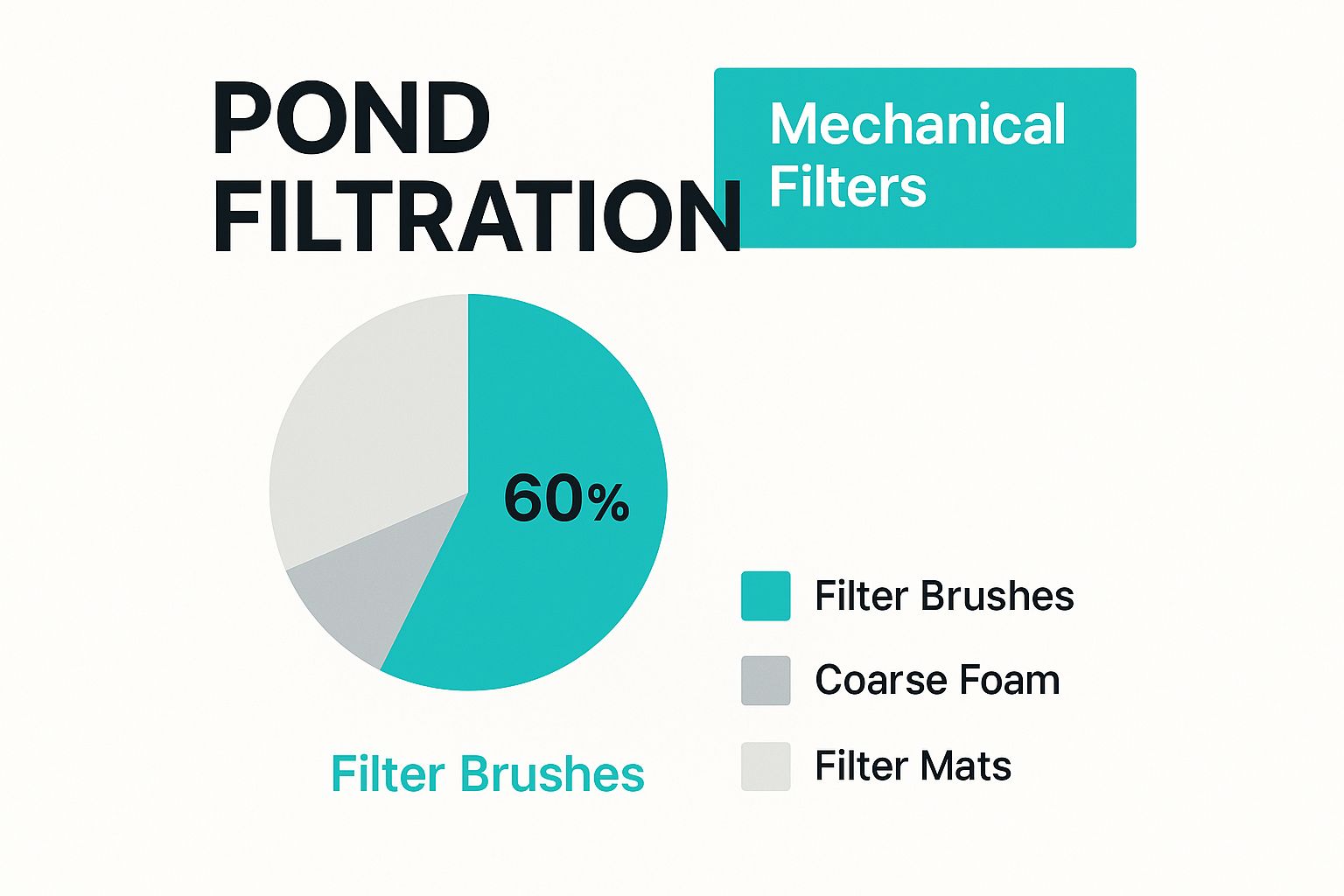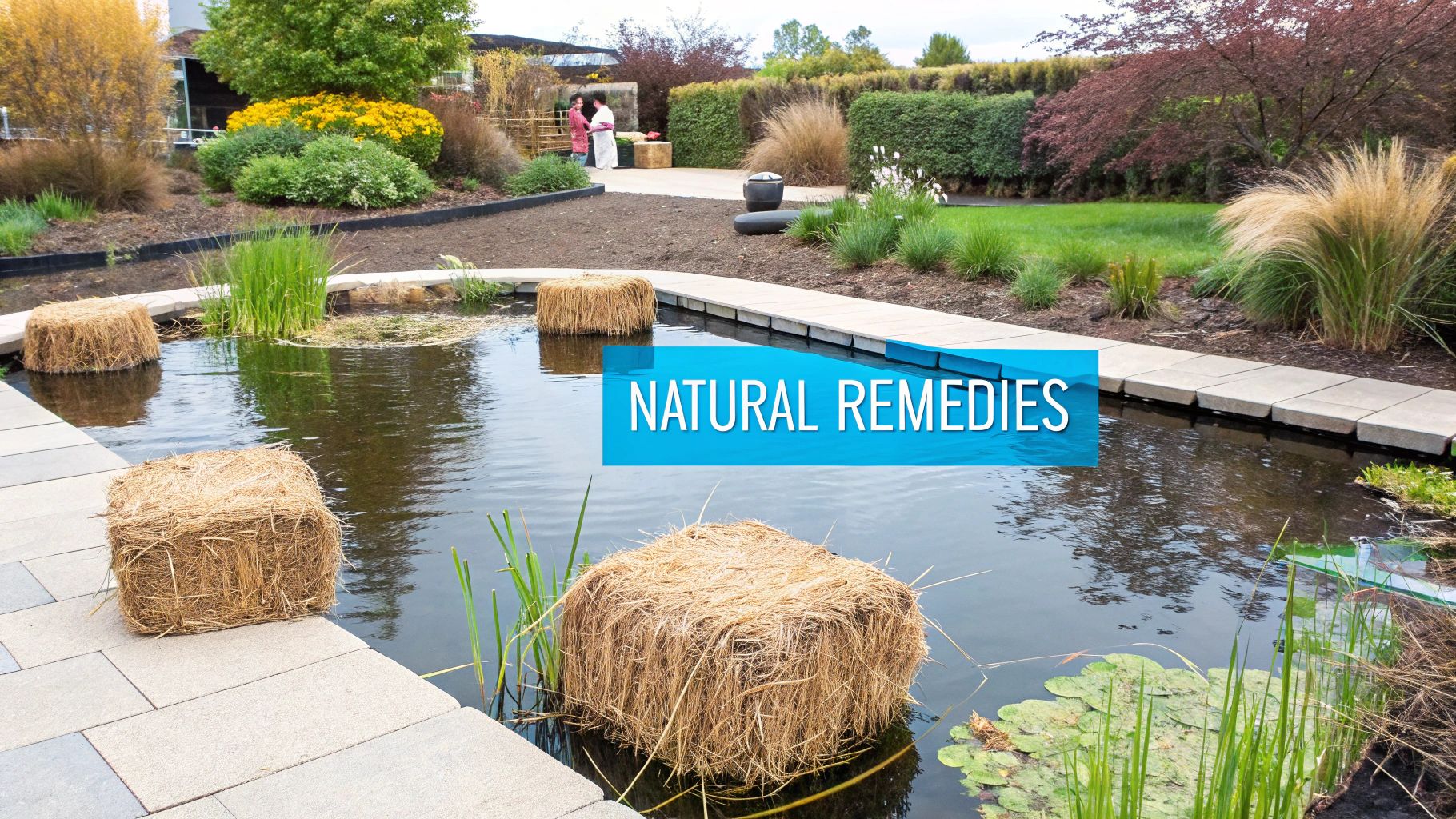Effective algae treatments for ponds begin with a clear diagnosis of the problem. Different types of algae require different solutions. The key is to first identify whether you're battling stringy blanket weed or murky green water, and then pinpoint the underlying cause, such as excess nutrients or sunlight.
Diagnosing Your Pond Algae Problem

Before applying any treatment, you must understand what you're up against. Algae is a sign that your pond's ecosystem is out of balance. Identifying the specific type of algae and its cause is the difference between a temporary fix and a long-term solution.
In UK ponds, you’ll typically encounter two main culprits. The first is filamentous algae, commonly known as blanket weed or string algae. This is the stubborn, green, hair-like growth that clings to waterfalls and pond liners, often forming thick mats on the surface.
The second is planktonic algae, the cause of the infamous "pea soup" pond. This consists of millions of tiny, single-celled organisms floating in the water, turning it a soupy, opaque green and hiding your fish from view.
Identifying the Root Causes
Algae thrives when conditions are right. Understanding these triggers is essential for any effective treatment plan.
-
Excess Nutrients: This is the primary fuel for algae growth. High levels of nitrates and phosphates act as a super-fertiliser for algae. These come from fish waste, uneaten food, and decaying organic debris.
-
Too Much Sunlight: A pond in direct sun all day is more prone to algae. Sunlight provides the energy algae needs for photosynthesis, especially during warmer months.
-
Poor Water Circulation: Stagnant water is an ideal breeding ground for algae. A lack of proper circulation prevents your filter from processing nutrients and can lead to low oxygen levels.
By identifying the specific trigger in your pond, you can shift from simply fighting visible algae to tackling the problem at its source for a healthier pond that stays clear.
The Impact on Your Pond's Health
An algae bloom is more than an eyesore; it can seriously harm your fish and the pond's stability. While algae produces oxygen during the day, it consumes it at night. A severe bloom can cause a critical overnight drop in dissolved oxygen, which is dangerous for fish.
When algae dies, the decomposition process consumes even more oxygen. It also releases stored nutrients back into the pond, fuelling the next bloom.
To understand the nutrient levels driving your algae problem, test your water regularly. Accurate readings for nitrate and phosphate will provide a clear picture of what's happening beneath the surface. For guidance, see our guide to the best water testing kit for ponds. Knowing your water parameters is the first step toward restoring your pond's balance.
Choosing the Right Algae Treatment Approach
Once you’ve identified the algae type and its likely cause, it's time to choose your battle plan. The best results come from combining methods suited to your pond's specific situation.
The four main approaches are biological, mechanical, chemical, and UV clarification. Each has its strengths and is best for different scenarios. Understanding these will help you make an informed choice that restores your pond's balance without harming fish or wildlife.
Biological Treatments The Natural Approach
Biological solutions restore your pond's natural balance. Instead of killing algae directly, they outcompete it for the nutrients it needs. This is a slower approach but creates long-term stability.
These treatments rely on two key elements:
- Beneficial Bacteria: These microorganisms break down organic waste like fish waste and dead leaves at the bottom of your pond. As they digest this sludge, they lock up the nitrates and phosphates that would otherwise fuel an algae bloom.
- Nutrient-Hungry Plants: Aquatic plants are excellent allies in the fight against algae. Fast-growing species like watercress and irises absorb excess nutrients directly from the water, effectively starving the algae.
A biologically balanced pond is a healthy pond. Encouraging a strong population of beneficial bacteria and plants creates a robust ecosystem that naturally keeps algae in check.
Mechanical Removal The Hands-On Method
Sometimes, the most direct approach is best. Mechanical removal involves physically taking the algae out of the pond. It provides an immediate visual improvement and is a crucial first step before using other treatments, especially for a heavy blanket weed infestation.
A simple long-handled brush or a specialised blanket weed rake will work. By manually pulling out as much stringy algae as you can, you instantly remove a large amount of nutrients from the ecosystem. This makes any subsequent treatments far more effective.
The diagram below shows how different filtration components, including mechanical filters, work together to keep a pond clear.

A modern pond filter has multiple stages. The mechanical part is crucial for catching physical debris before it can break down and feed the next round of algae.
Chemical Algaecides The Fast-Acting Solution
When an algae bloom is out of control, chemical treatments can be a quick solution. Modern, fish-safe algaecides are designed to target algae without harming your pond’s inhabitants, but only when used correctly.
These products work in various ways. Some disrupt the algae’s cellular structure, while others bind essential nutrients like phosphates, making them unavailable for algae. It is critical to calculate your pond's volume accurately and dose precisely according to the manufacturer's instructions.
UV Clarifiers The Green Water Zapper
If your main problem is "pea soup" green water caused by planktonic algae, a UV clarifier (UVC) is your best weapon. This device is plumbed into your filtration system. As water is pumped through, it is exposed to powerful ultraviolet light.
This UV radiation damages the algae's cellular walls, causing them to clump together. These clumps are then large enough to be captured and removed by your mechanical filter. The result is crystal-clear water, often in less than a week.
For more information, read our essential guide to UV clarifiers for ponds to see how effective they are.
Comparing Algae Treatment Methods
This table will help you compare the main treatment types. Consider your specific algae problem, how quickly you need results, and your willingness for hands-on effort.
| Treatment Method | Best For | Pros | Cons |
|---|---|---|---|
| Biological | Long-term prevention, nutrient control | Natural, safe, sustainable, improves overall pond health | Slow to take effect, may not handle severe blooms alone |
| Mechanical | Blanket weed, heavy infestations | Immediate visual results, removes nutrients from the system | Labour-intensive, doesn't address the root cause of growth |
| Chemical | Severe, out-of-control algae blooms | Fast-acting, highly effective for quick knockdown | Requires precise dosing, can disrupt pond balance if misused |
| UV Clarifier | Green water (planktonic algae) | Extremely effective, low maintenance, creates clear water | Only treats water-borne algae, requires electricity and installation |
A combination of these methods often yields the best, most sustainable results. For example, you might manually remove blanket weed, use a chemical treatment to knock back the rest, and then add beneficial bacteria and plants to prevent its return.
Applying Algae Treatments Safely and Effectively

Choosing the right algae treatment is only half the battle. Applying it correctly is crucial for a clear, healthy pond. A rushed job can lead to poor results or endanger your fish. A few preparatory steps can make all the difference.
Prepare Your Pond for Treatment
Before opening a bottle, a few preparatory steps are essential. These actions protect your fish and make the treatment more effective, especially when using a chemical algaecide.
Your top priority is oxygen. When a large amount of algae dies off at once, the decomposition process consumes a massive amount of dissolved oxygen. To counter this, you must boost aeration before and during the treatment.
- Add an extra air stone to the pond.
- Angle your pump outlet or waterfall to create more surface agitation.
- Clean existing aeration equipment to ensure it's running at full power.
This extra oxygen provides a vital safety net for your fish during an algae die-off.
Calculating the Correct Dosage
Guessing the dosage is a common and costly mistake. Under-dosing is a waste of time and money, while over-dosing can be toxic to your fish and wildlife.
Accuracy is key. First, you need to know your pond's volume in litres. For a square or rectangular pond, the formula is:
Length (m) x Width (m) x Average Depth (m) x 1000 = Volume in Litres
For irregularly shaped ponds, take measurements at several points and average them. Once you have an accurate volume, follow the product's instructions precisely.
A precise calculation is the foundation of a safe and successful treatment. Taking a few extra minutes to measure your pond properly prevents potential problems.
Safe and Even Application Techniques
How you add the treatment matters. Dumping it all in one spot creates a concentrated "hotspot" that can harm fish. Your goal is even distribution for consistent, safe results.
For liquid treatments, pre-dilute the measured dose in a bucket of pond water. Stir well, then slowly pour the mixture around the pond's edges or over your waterfall. This allows it to mix gently throughout the system.
The same principle applies to powders. Dissolve them completely in a bucket of pond water first to prevent clumps from sinking to the bottom. Adding a good quality PDV pond salt can also help support fish health during this time by improving their natural slime coat.
Post-Treatment Monitoring and Adjustments
Your job isn't done after the treatment is applied. You must monitor both the water and your fish.
Important Post-Application Checks:
- Switch Off Your UV Clarifier: Many chemical treatments are neutralised by UV light. It’s standard practice to switch your UVC off for 24-48 hours after application. Always check the product label for specific advice.
- Watch Your Fish Closely: Look for signs of distress. Fish gasping at the surface indicates low oxygen. If you see this, increase aeration immediately. Other warning signs include lethargy or erratic swimming.
- Clean Your Filters: As dead algae breaks down, it will clog your mechanical filter media. Be prepared to clean your filters more often in the days following a treatment to prevent reduced water flow.
By following these steps, your chosen algae treatments for ponds will work as intended, clearing the water while keeping your ecosystem safe.
How to Prevent Algae from Coming Back
Getting rid of an algae bloom is great, but preventing its return is the real victory. This requires shifting from reactive cures to proactive prevention. The goal is to create a balanced pond ecosystem where algae struggles to grow. This means tackling the two things algae loves most: nutrients and sunlight.
Starve the Algae by Managing Nutrients
An algae problem is a nutrient problem. You must cut off the supply of nitrates and phosphates. Overfeeding is a primary cause of nutrient overload. Fish should only be fed an amount they can consume within two to three minutes, once or twice a day. Uneaten food sinks and decays, releasing nutrients that fuel algae.
A well-fed fish is healthy, but an overfed fish is an algae factory. Reducing feeding is an impactful and free step to prevent future blooms.
Small, regular water changes are also key. Swapping out 10-15% of the water every one to two weeks helps dilute dissolved nutrients. This maintenance also replenishes essential minerals that benefit your fish and aquatic plants.
Optimise Your Pond’s Filtration and Circulation
Your filter system is your primary line of defence. Keep it well-maintained and ensure water circulates effectively throughout the entire pond. Poor circulation creates stagnant spots where algae can thrive.
Ensure your pond pump is correctly sized for your pond's volume. A good rule is that the entire pond volume should pass through the filter at least once per hour. If you're unsure, our ultimate guide to choosing a pond circulation pump can help.
Use Plants and Shade to Your Advantage
Nature offers excellent tools for preventing algae. Introducing the right aquatic plants creates direct competition for the nutrients algae needs.
Beneficial Plants for Algae Control:
- Floating Plants: Water Hyacinths and Duckweed are great at absorbing nutrients and providing shade.
- Marginal Plants: Water Iris and Watercress, placed on pond shelves, have extensive root systems that absorb nutrients.
- Submerged Oxygenators: Plants like Hornwort grow underwater, absorbing nutrients directly from the water while releasing oxygen.
Shade is another powerful, chemical-free tool. Algae needs sunlight for photosynthesis. Reducing the amount of direct sun hitting the water dramatically slows its growth. Water lilies are perfect for this, as their large pads cover the surface.
You can also use artificial shade like a pergola or sail shade. Aim for 40-60% surface coverage from a mix of plants and shade. This holistic approach is the secret to long-term, sustainable algae treatments for ponds.
Dealing with Algae That Just Won't Quit
Even with a solid plan, some algae problems can be persistent. If algae returns after treatment, it usually means an underlying issue has been missed. Let's explore common scenarios to fine-tune your approach.
Why Did the Blanket Weed Return So Fast?
If you've removed blanket weed and treated the pond, only for it to return quickly, the cause is likely a continuous source of nutrients.
Your first suspect should be pond sludge. A thick layer of decomposed leaves, fish waste, and old food on the pond floor acts as a slow-release fertiliser for algae. While treatments kill existing algae, they often don't address this underlying nutrient source.
Runoff is another common culprit. After heavy rain, water from your lawn or patio can wash fertilisers and pollutants into your pond, triggering a new bloom. Check the pond edge and consider diverting runoff with a small berm or strategic planting.
Is My UV Clarifier Not Working?
If you have a UV clarifier (UVC) but your pond is still green, it's rarely the unit itself. More often, it's one of three maintenance issues.
- UV Bulb Age: UV bulbs are effective for only 9-12 months of continuous use. It may still glow, but its UV output will have significantly dropped. Replace it every spring.
- Dirty Quartz Sleeve: The UV bulb sits inside a glass tube called a quartz sleeve. Over time, a film of limescale and grime can build up, blocking the UV light. Carefully cleaning the sleeve can restore its effectiveness.
- Incorrect Water Flow Rate: Water needs to pass through the UVC slowly enough for a proper dose of UV radiation. If your pump is too powerful, water rushes through too quickly. Check the manufacturer's recommended flow rate for your model and ensure your pump is compatible.
Check these three fundamentals before giving up on your equipment. A simple bulb change or a quick clean is often all it takes to restore water clarity.
Adjusting Your Long-Term Strategy
If algae keeps winning, your pond's ecosystem is out of balance. It's time to shift from reactive algae treatments for ponds to proactive, long-term management.
Honestly assess your fish stocking levels—too many fish create more waste than the filtration can handle. Consider adding more aquatic plants to outcompete algae for nutrients.
Regular water testing provides crucial clues, highlighting high nitrate or phosphate levels. For more on maintaining water quality, learning how to plan your koi pond water changes can help you establish a routine to dilute nutrients and keep the environment stable. By pinpointing the true source of the problem, you can break the cycle and achieve a permanently clear pond.
How Long Until I See Results?
The time it takes to see results depends on the treatment method.
- Chemical algaecides are fast-acting. You’ll often see a dramatic change within 24 to 72 hours.
- UV clarifiers are also quick for green water. A properly sized unit can restore clarity in 3 to 7 days.
- Biological treatments like beneficial bacteria work slowly. It can take several weeks for bacterial colonies to establish and reduce sludge and nutrients.
Are Algae Treatments Safe for My Koi?
Yes, but only if you follow the instructions precisely. Reputable algae treatments are formulated to be safe for koi and other wildlife when used as directed.
The main danger is not the treatment itself, but the oxygen depletion from a large algae die-off. As dead algae decomposes, bacteria consume a tremendous amount of dissolved oxygen, which can harm your fish.
It is essential to know your pond's volume for correct dosing. Most importantly, increase aeration before, during, and after applying a chemical treatment to protect your fish.
Can I Use Multiple Algae Treatments at Once?
Combining different types of treatment is often the most effective approach. However, you must not mix different chemical treatments together, as this can cause dangerous reactions.
A multi-pronged strategy can be highly effective. For example, running a UV clarifier for green water while adding beneficial bacteria to break down sludge is a great approach. This tackles both the symptom and a root cause, helping you build a truly healthy pond ecosystem.
For everything you need to keep your pond in top condition—from effective algaecides and UV clarifiers to beneficial bacteria and premium koi food—take a look at the full collection at Hatton Koi. We've got all the tools you need to win the battle for clear, healthy water. Find out more at https://hattonkoi.com.

